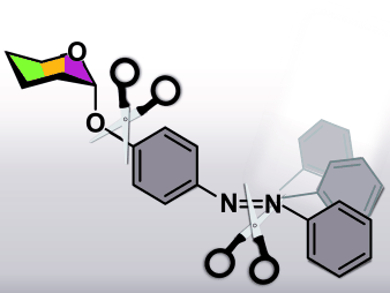Carbohydrate recognition is an important biological process that is essential for the communication between cells, such as cellular adhesion and recognition. A control of the spatial orientation of these carbohydrate units could potentially be used to modify this recognition event.
Thisbe Lindhorst and colleagues, University of Kiel, Germany, synthesized azobenzene glycosides with systematically varied structural properties using glycoside synthesis and the Mills reaction. The incorporation of an azobenzene moiety enables photoinduced E to Z isomerization leading to a different temporal orientation of the glycoside units. The photochromic properties of these different glycoconjugates were tested, and the results show that the anomeric linkage of a glycoside and the configuration of the 2-OH group can be crucial for the photoisomerization properties.
 Synthesis and Photochromic Properties of Configurationally Varied Azobenzene Glycosides
Synthesis and Photochromic Properties of Configurationally Varied Azobenzene Glycosides
Vijayanand Chandrasekaran, Eugen Johannes, Hauke Kobarg, Frank D. Sönnichsen, Thisbe K. Lindhorst
ChemistryOpen 2014.
DOI: 10.1002/open.201402010




